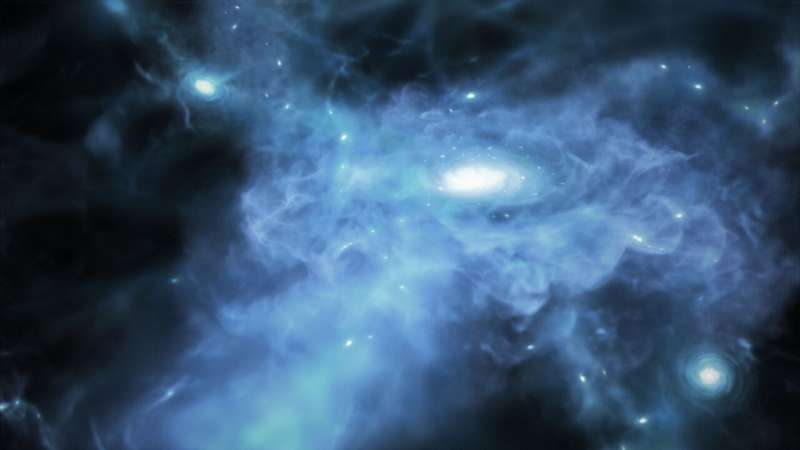This article has been reviewed according to Science X's editorial process and policies. Editors have highlighted the following attributes while ensuring the content's credibility:
fact-checked
peer-reviewed publication
trusted source
proofread
Birth of universe's earliest galaxies observed for first time

Using the James Webb Space Telescope, University of Copenhagen researchers have become the first to see the formation of three of the earliest galaxies in the universe, more than 13 billion years ago. The sensational discovery contributes important knowledge about the universe and is now published in Science.
For the first time in the history of astronomy, researchers at the Niels Bohr Institute have witnessed the birth of three of the universe's absolute earliest galaxies, somewhere between 13.3 and 13.4 billion years ago.
The discovery was made using the James Webb Space Telescope, which brought these first "live observations" of formative galaxies down to us here on Earth.
Through the telescope, researchers were able to see signals from large amounts of gas that accumulate and accrete onto a mini-galaxy in the process of being built. While this is how galaxies are formed according to theories and computer simulations, it had never actually been witnessed.
"You could say that these are the first 'direct' images of galaxy formation that we've ever seen. Whereas the James Webb has previously shown us early galaxies at later stages of evolution, here we witness their very birth, and thus, the construction of the first star systems in the universe," says Assistant Professor Kasper Elm Heintz from the Niels Bohr Institute, who led the new study.
Galaxies born shortly after the Big Bang
The researchers estimate the birth of the three galaxies to have occurred roughly 400–600 million years after the Big Bang, the explosion that began it all. While that sounds like a long time, it corresponds to galaxies forming during the first 3–4% of the universe's 13.8-billion-year overall lifetime.
Shortly after the Big Bang, the universe was an enormous opaque gas of hydrogen atoms—unlike today, where the night sky is speckled with a blanket of well-defined stars.
"During the few hundred million years after the Big Bang, the first stars formed, before stars and gas began to coalesce into galaxies. This is the process that we see the beginning of in our observations," explains Associate Professor Darach Watson.
The birth of galaxies took place at a time in the history of the universe known as the Epoch of Reionization, when the energy and light of some of the first galaxies broke through the mists of hydrogen gas.
It is precisely these large amounts of hydrogen gas that the researchers captured using the James Webb Space Telescope's infrared vision. This is the most distant measurement of the cold, neutral hydrogen gas, which is the building block of the stars and galaxies, discovered by scientific researchers to date.
Adds to the understanding of our origins
The study was conducted by Kasper Elm Heintz, in close collaboration with--among others--research colleagues Darach Watson, Gabriel Brammer and Ph.D. student Simone Vejlgaard from the Cosmic Dawn Center at the University of Copenhagen's Niels Bohr Institute—a center whose stated goal is to investigate and understand the dawn of the universe. This latest result brings them much closer to doing just that.
The research team has already applied for more observation time with the James Webb Space Telescope, with hopes of expanding upon their new result and learning more about the earliest epoch in the formation of galaxies.
"For now, this is about mapping our new observations of galaxies being formed in even greater detail than before. At the same time, we are constantly trying to push the limit of how far out into the universe we can see. So, perhaps we'll reach even further," says Vejlgaard.
According to the researcher, the new knowledge contributes to answering one of humanity's most basic questions.
"One of the most fundamental questions that we humans have always asked is 'Where do we come from?' Here, we piece together a bit more of the answer by shedding light on the moment that some of the universe's first structures were created. It is a process that we'll investigate further, until hopefully, we are able to fit even more pieces of the puzzle together," concludes Associate Professor Brammer.
The study was conducted by researchers Kasper E. Heintz, Darach Watson, Gabriel Brammer, Simone Vejlgaard, Anne Hutter, Victoria B. Strait, Jorryt Matthee, Pascal A. Oesch, Pall Jakobsson, Nial R. Tanvir, Peter Laursen, Rohan P. Naidu, Charlotte A. Mason, Meghana Killi, Intae Jung, Tiger Yu-Yang Hsiao, Abdurro'uf, Dan Coe, Pablo Arrabal Haro, Steven L. Finkelstein, & Sune Toft.
More information: Kasper E. Heintz, Strong damped Lyman-α absorption in young star-forming galaxies at redshifts 9 to 11, Science (2024). DOI: 10.1126/science.adj0343. www.science.org/doi/10.1126/science.adj0343
Journal information: Science
Provided by University of Copenhagen




















